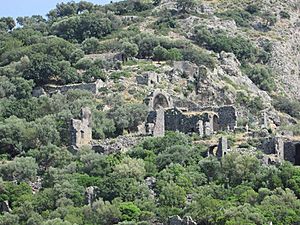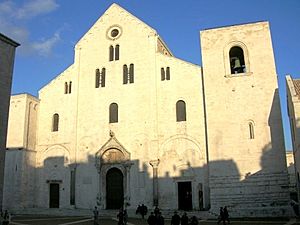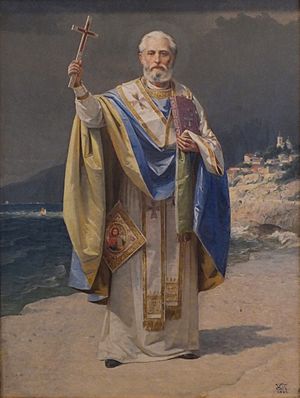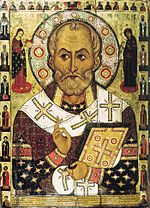Saint Nicholas facts for kids
Quick facts for kids SaintNicholas |
|
|---|---|
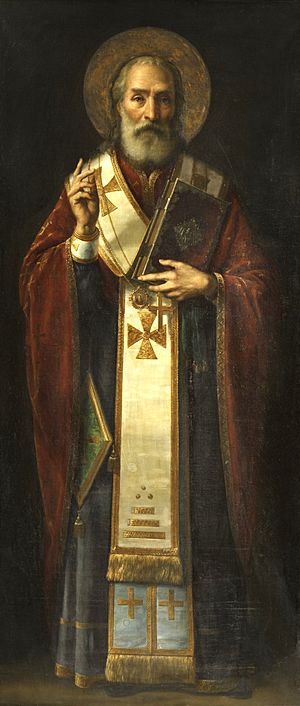
Full-length icon by Jaroslav Čermák, showing Saint Nicholas with a halo, dressed in clerical garb, and holding a book of the scriptures in his left hand while making the hand gesture for the sign of the cross with his right
|
|
|
|
| Born | Traditionally 15 March 270 Patara, Lycia et Pamphylia, Roman Empire |
| Died | Traditionally 6 December 343 (aged 73) Myra, Diocese of Asia, Roman Empire |
| Venerated in | All Christian denominations which venerate saints |
| Major shrine | Basilica di San Nicola, Bari, Italy |
| Feast |
|
| Attributes | Vested as a bishop. In Eastern Christianity, wearing an omophorion and holding a Gospel Book. Sometimes shown with Jesus Christ over one shoulder, holding a Gospel Book, and with the Theotokos over the other shoulder, holding an omophorion, holding three golden balls or coins |
| Patronage |
|
Saint Nicholas of Myra, also known as Nicholas of Bari, was an early Christian bishop. He was born in Greece, in a city called Myra in Asia Minor (modern-day Turkey). This was during the time of the Roman Empire. People believed he performed many miracles, so he was also known as Nicholas the Wonderworker.
Saint Nicholas is the patron saint of many groups. These include sailors, merchants, archers, and children. He is also a patron for students in many cities across Europe. His reputation grew over time, like other early Christian saints. His habit of secretly giving gifts led to the idea of Santa Claus.
Not much is known for sure about the real Saint Nicholas. The first stories about his life were written centuries after he died. These stories likely include some legends. He is said to have been born in Patara, a Greek seaport in Asia Minor. His parents were wealthy Christians.
Early stories say he calmed a storm at sea. He also saved three innocent soldiers from being wrongly executed. Another story tells of him cutting down a tree that was thought to be possessed by a demon. When he was young, he traveled to Egypt and Palestine. Soon after returning, he became the Bishop of Myra. He was later put in prison during a time when Christians were persecuted. But he was released when Constantine the Great became emperor.
A list from early times says he attended the First Council of Nicaea in 325 AD. However, no one who was at the council mentioned him in their writings. Later stories, which are not proven, claim he was temporarily removed from his duties. They say he was imprisoned during the council for slapping a religious leader named Arius. Another famous, but late, legend says he brought three murdered children back to life.
Less than 200 years after Nicholas died, the St. Nicholas Church, Demre was built in Myra. This was ordered by Theodosius II at the site of the church where Nicholas had served. His remains were moved to a special stone coffin there.
In 1087, the Greek Christians in the area were ruled by the Muslim Seljuk Turks. Also, their church was declared to be in schism by the Catholic church. At this time, a group of merchants from Bari, Italy, took Nicholas's main bones. They removed them from his coffin in the church without permission. They brought the bones to their hometown, where they are now kept in the Basilica di San Nicola. The smaller bone pieces left in the coffin were later taken by sailors from Venice. They brought them to Venice during the First Crusade.
Contents
Who Was Saint Nicholas?
Very little is known about the actual historical life of Saint Nicholas. Any writings Nicholas might have created are now lost. No writers from his time mentioned him. This is not surprising, as Nicholas lived during a difficult time in Roman history. Also, all records were kept on papyrus or parchment. These materials were not as strong as modern paper. Texts had to be copied by hand often to be saved.
The earliest mentions of Saint Nicholas show that his worship was already strong by the sixth century. Less than 200 years after Nicholas likely died, the Roman Emperor Theodosius II ordered a church built for Saint Nicholas in Myra. This church helps us know his name from early times. The historian Procopius also wrote that Emperor Justinian I fixed up churches in Constantinople. These churches were dedicated to Saint Nicholas and Saint Priscus. They might have been built as early as 490 AD.
Nicholas's name also appears on a list of people who attended the Council of Nicaea. This list was made by the historian Theodoret around 510-515 AD. A brief mention of Nicholas of Myra is also found in the story of another saint, Saint Nicholas of Sion. This saint apparently took the name "Nicholas" to honor him. The Life of Saint Nicholas of Sion, written about 250 years after Nicholas of Myra's death, mentions Nicholas of Sion visiting Nicholas's tomb. This was to show respect. Historian Jeremy Seal says that the fact Nicholas had a tomb that could be visited is almost the only proof he was a real person.
The earliest full story of Nicholas's life that we still have was written in the early 800s. It was written by Michael the Archimandrite. This was almost 500 years after Nicholas likely died.
Stories and Legends
Stories about Saint Nicholas's life mostly agree on the main points. But modern historians are not sure how much of these stories are true history. Traditionally, Nicholas was born in Patara, a port city in Asia Minor. His family was wealthy and Greek Christian. Some stories say his parents were Epiphanius and Johanna. Others say they were Theophanes and Nonna. In some accounts, Nicholas's uncle was the bishop of Myra. Seeing his nephew's strong faith, Nicholas's uncle made him a priest.
Nicholas's Generosity
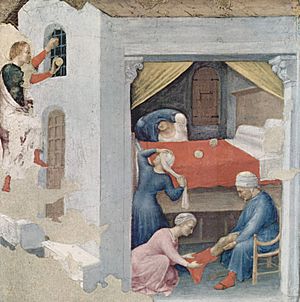
After his parents died, Nicholas is said to have given all their money to the poor. His most famous act of kindness is first told in Michael the Archimandrite's story. Nicholas heard about a good man who had lost all his money. This man could not afford proper dowries for his three daughters. Without dowries, they could not get married.
Nicholas wanted to help them. But he was too humble to help in public. He also wanted to save the family from feeling ashamed. So, he went to their house at night. He threw a purse full of gold coins through an open window. The father quickly arranged a marriage for his first daughter. After her wedding, Nicholas threw a second bag of gold through the same window late at night.
According to the story, after the second daughter was married, the father stayed awake. He waited for at least two nights. He then caught Saint Nicholas doing the same kind act for the third daughter. The father fell to his knees, thanking him. Nicholas told him not to tell anyone about the gifts. This scene of Nicholas's secret gift-giving is very popular in Christian art. It appears in paintings and frescoes across Europe. Nicholas is often shown wearing a hood. The daughters are usually in bed, wearing their nightclothes.
Historians debate if this event really happened. Some argue it might be true because the story is very old. Also, no similar stories were told about other saints. Others note that a similar story is in a book about a philosopher named Apollonius. But Michael the Archimandrite's story is quite different.
In another story, Nicholas is said to have visited the Holy Land. The ship he was on was almost destroyed by a terrible storm. But he calmed the waves, and the storm stopped. Because of this, Nicholas became known as the patron saint of sailors and travelers.
Becoming Bishop of Myra

After visiting the Holy Land, Nicholas returned to Myra. The bishop of Myra, who took over after Nicholas's uncle, had recently died. The priests in the city decided that the first priest to enter the church that morning would become the new bishop. Nicholas went to the church to pray. So, he was named the new bishop.
He is said to have been imprisoned and tortured during a time of great persecution of Christians. This was under Emperor Diocletian. But he was released when Emperor Constantine the Great came to power. This story sounds possible. However, it is not found in the earliest writings. So, it is probably not historical.
One of the oldest stories about Saint Nicholas is how he saved three innocent men from being executed. According to Michael the Archimandrite, three innocent men were sentenced to death by the governor. As they were about to be killed, Nicholas appeared. He pushed the executioner's sword to the ground. He freed the men from their chains. He also angrily scolded a juror who had taken a bribe.
Later versions of this story are more detailed. They combine two stories. One version says Emperor Constantine sent three generals to stop a rebellion. A storm made them stop in Myra. Nicholas found out their soldiers were causing trouble. He confronted the generals, and they stopped the looting. Right after, Nicholas heard about the three innocent men. The generals helped him stop the execution. Nicholas also made the corrupt governor change his ways. Later, the generals were falsely accused. Nicholas appeared to Constantine and the accuser in dreams. This led to the generals being set free.
The Council of Nicaea
In 325 AD, Nicholas is said to have attended the First Council of Nicaea. Here, he was a strong opponent of Arianism. He strongly supported the idea of the Trinity. He was one of the bishops who signed the Nicene Creed. Nicholas's attendance at the council is mentioned early on a list of attendees. However, he is never mentioned by Athanasius of Alexandria, who was a main defender of the Trinity. Athanasius knew all the important bishops of that time. Nicholas is also not mentioned by the historian Eusebius, who was also at the council.
A later legend, first told over 1,000 years after Nicholas died, says that during the Council of Nicaea, Nicholas got angry. He slapped "a certain Arian" across the face. Because of this, Emperor Constantine took away Nicholas's special bishop's hat and cloak. This story is very late, so it probably did not happen. Later versions of the legend make it more dramatic. They say Nicholas punched Arius himself. In these stories, Nicholas is also put in prison. But Christ and the Virgin Mary appear to him in his cell. They free him and give back his special clothes. This scene of Nicholas slapping Arius is shown in Eastern Orthodox art.
= Other Miracles
One story tells how, during a terrible famine, a bad butcher tricked three little children. He killed them and put their bodies in a barrel to sell as ham. Nicholas visited the area to help the hungry. He saw through the butcher's lies. He brought the children back to life by making the sign of the cross. This story might seem strange today, but it was very popular in the Middle Ages. It is shown in stained glass, paintings, and tapestries.
Another story says that during a great famine in Myra, a ship was in the port. It was loaded with wheat for the emperor. Nicholas asked the sailors to unload some wheat to help the people. The sailors did not want to at first. The wheat had to be weighed exactly for the emperor. Nicholas promised them they would not lose any wheat. So, the sailors agreed. When they arrived in the capital, they were surprised. The weight of the load had not changed. But the wheat taken in Myra was enough for two full years and could even be used for planting.
Saint Nicholas's Relics
Gemile Island
It was traditionally thought that Saint Nicholas was buried in his hometown of Myra. His relics (remains) were later known to be kept there. However, some new discoveries suggest he might have been buried in a church on the small Turkish island of Gemile. This island is only twenty miles from Patara, where he was born. Nicholas's name is painted on part of the ruined building. In ancient times, the island was called "Saint Nicholas Island." Today, it is called Gemiler Adasi, meaning "Island of Boats." This name refers to Saint Nicholas being the patron saint of sailors.
The church was built in the fourth century, around the time Nicholas died. It looks like other saints' shrines from that period. Nicholas was the only major saint linked to that part of Turkey. The church where historians believe he was first buried is at the western end of a large pathway.
Myra
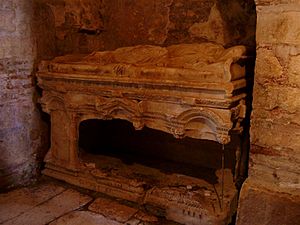
In the mid-600s, Gemile Island was easy for Arab fleets to attack. So, Nicholas's remains seem to have been moved from the island to Myra. Myra is about 40 kilometers east of Gemile. Being further inland made it safer from sea attacks.
It is said that in Myra, Saint Nicholas's relics produced a clear, watery liquid each year. It smelled like rose water and was called manna or myrrh. People believed it had miraculous powers. Because it was known that all of Nicholas's relics were in Myra in their sealed coffin, it was rare for people to fake having his relics during this time.
In 2000, the Russian government gave a bronze statue of the saint. It was placed in front of the medieval Church of St Nicholas. In 2005, the mayor replaced it with a plastic Santa Claus statue. He wanted something more recognizable to tourists. But the Russian government protested, and the bronze statue was returned.
In 2009, the Turkish government announced it would formally ask Italy to return Saint Nicholas's bones. Turkish authorities said Nicholas wanted to be buried in his bishop's town. They also said his remains were taken illegally. In 2017, archaeologists found a temple below the modern church in Demre. They plan to dig more to see if Nicholas's body is still there.
Bari, Italy
After a battle in 1071, the Byzantine Empire lost control of most of Asia Minor. So, Greek Christians in Myra became subjects of the Turks. At the same time, the Catholic Church in the West said the Greek church was in schism. Because of many wars, some Christians worried that getting to the tomb might become hard.
In 1087, Italian sailors from Bari took advantage of the situation. They took part of the saint's remains from his church in Myra. This was against the wishes of the Greek Orthodox monks. The sailors brought the remains to Bari and took care of them. The remains arrived on May 9, 1087. Two years later, Pope Urban II opened a new church for Saint Nicholas in Bari. The Pope himself placed Nicholas's relics under the altar of the new church.
The removal of Saint Nicholas's relics to Bari is well-recorded by many writers. Western Christians still celebrate May 9 each year as the day Nicholas's relics were moved. Eastern Orthodox Christians and the Turks have long seen this as a theft. But the people of Bari say it was a rescue mission to save the bones from Turkish invaders. A legend says Nicholas once visited Bari and predicted his bones would rest there one day.
Before his relics came to Bari, Saint Nicholas was not very popular in Western Europe. In 1096, soldiers gathered in Bari for the First Crusade. Even though Crusaders usually liked warrior saints, Nicholas's relics in Bari made him easy to worship. His connection to helping travelers and sailors also made him popular. Crusaders worshipping Nicholas helped spread his fame across Western Europe.
After the relics were brought to Bari, they continued to produce "myrrh." This made their new owners happy. Small bottles of myrrh from his relics have been taken all over the world for centuries. You can still get them from his church in Bari. Even today, a flask of manna is taken from Saint Nicholas's tomb every year on December 6. This is his feast day. The liquid slowly seeps out of the tomb. It is not clear if it comes from the body or the marble itself. Since Bari is a harbor town and the tomb is below sea level, some natural reasons have been suggested for the fluid.
In 2017, a part of St. Nicholas's relics from Bari was sent to Moscow. This happened after talks between Pope Francis and Russian Orthodox Patriarch Kirill. The relic was shown for worship at Christ the Savior Cathedral. Then it went to Saint Petersburg before returning to Bari. More than a million people in Moscow waited to see the special container holding one of the saint's ribs.
Venice
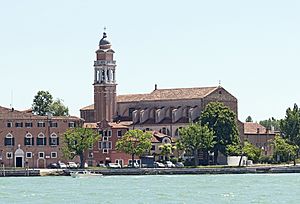
The sailors from Bari only took the main bones of Nicholas's skeleton. They left all the smaller pieces in the grave. The city of Venice wanted to get the remaining pieces. In 1044, they built the San Nicolò al Lido monastery church for him.
According to one story, in 1100, Venetian ships sailed past Myra on their way to Palestine. A bishop insisted the fleet turn back and stop in Myra. The Venetians took the remaining bones of Saint Nicholas. They also took bones of other bishops from the church. The church was only guarded by four Orthodox monks. They brought the bones to Venice and put them in the San Nicolò al Lido. This story was supported by two scientific studies. These studies looked at the relics in Bari and Venice. They confirmed that the bones in both cities fit together. They could belong to the same person. It is said that someone dies every time the bones of Saint Nicholas in Venice are disturbed. The last time the bones were checked was in July 1992.
Other Locations
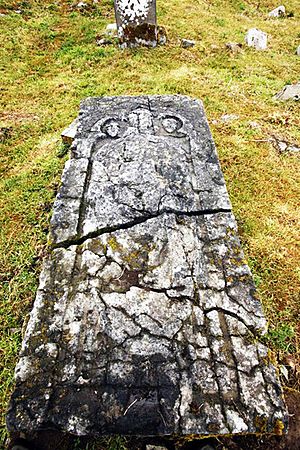
Because Nicholas's skeleton was in Myra for a long time, the demand for pieces of it grew after it was brought to Bari. Small bones quickly spread across Western Europe. The sailors who moved the bones gave one tooth and two pieces from Nicholas's coffin to a knight. This knight took these relics to his hometown in Normandy.
According to legend, in 1101, Saint Nicholas appeared to a French clerk. He told him to take one of his bones to his hometown of Port, near Nancy. The clerk took a finger bone back to Port. A chapel was built there for Saint Nicholas. Port became an important center for worshipping Nicholas. In the 1400s, a church called the Basilique Saint-Nicolas was built there for him. The town is now called "Saint Nicolas de Port" in his honor.
The clergy in Bari strategically gave away samples of Nicholas's bones. This helped spread his worship and increase its importance. Many of these bones were first kept in Constantinople. But after the city was attacked in 1204 during the Fourth Crusade, these pieces were scattered across Western Europe. A hand said to belong to Saint Nicholas was kept in a church in Rome. This church was built where a prison used to be. Stories quickly grew that Nicholas himself had been held in that prison. Mothers would pray to Saint Nicholas for their jailed sons to be released. Criminals who wanted to change their ways would leave offerings in the church. Because of this, Nicholas became the patron saint of prisoners and those wrongly accused.
An Irish tradition says that Saint Nicholas's relics were also stolen from Myra. This was done by local Norman crusading knights in the 1100s. They were buried near Thomastown, Ireland. A stone slab marks the spot believed to be his grave. However, one expert believes the tomb likely belongs to a local priest.
Honoring Saint Nicholas
Among Greeks and Italians, he is a favorite saint for sailors, fishermen, and ships. Because of this, he has become the patron saint of several cities with harbors. In Greek folklore, Nicholas was seen as "The Lord of the Sea." Modern Greek scholars often describe him as a Christian version of the sea god Poseidon. In modern Greece, he is still one of the most recognized saints. Many cities celebrate their patron saint on December 6. He is also the patron saint of all of Greece and especially of the Hellenic Navy.
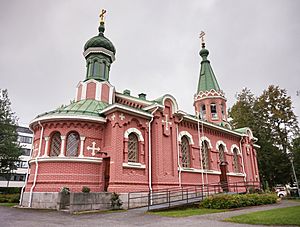
In the Eastern Orthodox Church, Saint Nicholas is remembered almost every Thursday of the year. Special hymns are sung to him. Soon after his relics moved from Myra to Bari, a Russian story of his life was written.
Special prayers and songs have been made in his honor. People often sing them when they ask for his help. He is mentioned in church services. Many Orthodox churches have his icon, even if they are not named after him. In some Eastern Orthodox churches, Saint Nicholas's departure is celebrated on December 19.
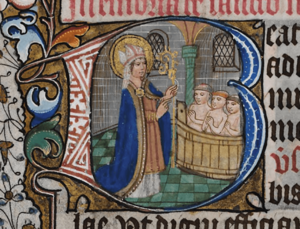
Nicholas was known for secretly giving gifts. For example, he would put coins in shoes left out for him. This practice is celebrated on his feast day, December 6. For those who still use the Julian calendar, the celebration happens thirteen days later.
In Monaco, a cathedral was built on the site of St Nicholas's church. A children's Mass is still held on December 6 in the cathedral.
In medieval England, on Saint Nicholas Day, churches held "boy bishop" celebrations. Young people acted as priests and bishops. They even ruled over their elders. Today, Saint Nicholas is still celebrated as a great gift-giver in parts of Europe. In medieval times, Christian nuns in Belgium and France started leaving baskets of food and clothes anonymously for the needy. This led to the practice of gift-giving on Saint Nicholas Day.
Another custom is that on December 6, sailors would go to harbor towns. They would celebrate their patron saint in church. On the way back, they would stop at "Nicholas fairs." They would buy rare goods, gifts for loved ones, and small presents for their children. The real gifts would be given at Christmas. But the small presents for children were given right away, thanks to Saint Nicholas. This, and the story of him bringing three murdered children back to life, made Saint Nicholas a patron saint of children and later students. The custom of giving gifts on Saint Nicholas Day is popular. A common tradition is for children to put their shoes in the entrance of their home. Saint Nicholas then delivers presents in them.
Santa Claus developed from Dutch traditions about Saint Nicholas (Sinterklaas). When the Dutch started the colony of New Amsterdam, they brought the legends of Sinterklaas with them. The tradition of celebrating Sinterklaas in New York existed in early Dutch settlements. St. Nicholas Park in New York City is named for St. Nicholas of Myra.
Nicholas is honored in the calendars of saints for Lutheran, Church of England, and Episcopal Churches on December 6.
Feast Days for Saint Nicholas
- April 1 – Marks the start of the journey of his relics from Myra to Bari in 1087.
- May 9 – The day his relics were moved from Myra to Bari in 1087.
- May 10 – The passage of his relics through Zakynthos Island in 1087.
- May 20 – The arrival of his relics in Bari.
- July 29 – The birth of Saint Nicholas.
- A movable holiday between August 16 and 22 – A gathering of all Saints of Lefkada.
- September 22 – A gathering of all Saints of Tula (remembering the protection of Tula in 1552).
- December 6 – The anniversary of his death.
How Saint Nicholas is Shown in Art
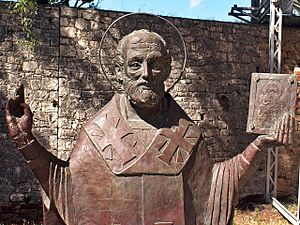

Saint Nicholas is a very popular subject in Eastern Orthodox icons. This is especially true for Russian and Serbian icons. He is shown as an Orthodox bishop. He wears a special scarf called an omophorion and holds a Gospel Book. Sometimes he wears an Eastern Orthodox mitre (a tall hat), and sometimes he is bareheaded. In art, Nicholas is shown as an old man with a short, full, white beard and a balding head.
To remember the miracle at the First Council of Nicaea, he is sometimes shown with Christ over his left shoulder. Christ holds out a Gospel Book to him. The Theotokos (Virgin Mary) is over his right shoulder, holding the omophorion. Because he helps sailors, Saint Nicholas is sometimes shown in a boat or saving drowning sailors.
In art from Bari, Saint Nicholas is usually shown with dark skin. This might be to show he came from a foreign land. This could have made Bari seem more important, as it attracted a saint from far away. In Roman Catholic art, Saint Nicholas is shown as a bishop. He wears the special clothes of a bishop: a bishop's vestments, a mitre, and a crozier (a staff). The story of the three dowries is remembered by showing him holding three purses, three coins, or three gold balls. Depending on if he is shown as the patron saint of children or sailors, his images will have ships, children, or three figures climbing out of a wooden barrel (the three children he brought back to life).
Sometimes, the three gold balls that refer to the dowry story are shown as oranges or other fruits. In the Low Countries during medieval times, oranges often came from Spain. This led to the belief that the Saint lives in Spain. He comes to visit every winter, bringing oranges, other winter fruits, and stories of magical creatures.
Music
In 1948, Benjamin Britten finished a cantata called Saint Nicolas. It tells the saint's legendary life through a series of dramatic events. A tenor singer plays Saint Nicolas. There is also a mixed choir, boy singers, strings, piano, organ, and percussion.
See also
 In Spanish: Nicolás de Bari para niños
In Spanish: Nicolás de Bari para niños
- Saint Nicholas (European folklore)
- Companions of Saint Nicholas
- Saint Nicholas Day
- Saint Nicholas, patron saint archive
- Belznickel
- St. Nicholas Church (disambiguation)



